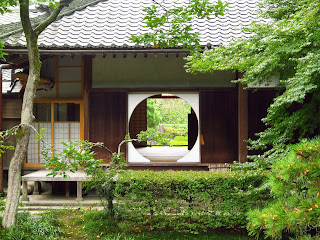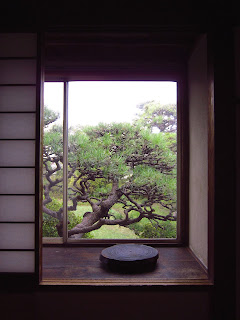Super Big Japan Style
The escapades and misadventures of an American artist in Japan.
Thursday, June 10, 2021
End (終)
Wednesday, September 30, 2020
Rice harvest (稲刈り)
Rice is one of the world's most labor intensive foods. I discovered this first hand recently when I took part in a traditional rice harvest.
Rice in Japan is usually harvested in September. Some farmers mow it down at the beginning of the month, some wait until the end. This being the 21st Century most of them use machines for this process. But for some 3,000 years this was not the case. In fact, mechanized rice farming wasn't introduced until the mid 20th Century. One of the reasons for this is heavy machinery is difficult or impossible to move through soft, muddy rice paddies. Also, about 70% of Japan is mountainous, so a lot of rice farming used to be done on steep terraced hillsides which were inaccessible to tractors and other farming equipment.
Koubakai (倖馬会) is a horse stable in Kuta (久多), a small mountain village in northern Kyoto. They also grow rice on a small 150 tsubo (497 m2) plot of land. This is not for commercial purposes. The rice is dedicated to the deities at Kamigamo shrine in an autumn festival called Hono-sai (奉納祭). Each year Koubakai invites people to join in first the planting of the rice in the spring, and then the harvesting of the rice in the autumn.
The day of the harvest I was given a pair of tall rubber boots, gloves and a wicked, razor-toothed sickle called a kama (鎌) in Japanese. After a brief demonstration the 20 or so people stepped into the ta (rice paddy).
Rice paddies are submerged in about 10cm of water for 6 months. They are drained just a day or two before the harvest. This means the soil is incredibly wet and loose, something like over-cooked pudding. Watching people sink into and then try to get out of the muck was a sort of comedy routine straight out of I Love Lucy.
The sickle rips through the rice stalk with ease. This sound is curiously pleasing. The stalks are bundled and then hung panicle-side down on long horizontal racks called hazagi. This method of drying rice slowly in the sunshine is said to produce tastier rice.
This is back-breaking work. But once you find a rhythm it goes quickly. The small paddy with 20 amateur farmers was reaped in about two hours.
As a child I used to visit my uncle's farm in central California. I always enjoyed these rural vacations. As urbanites, it is easy to romanticize farm work. But there is something very satisfying in this labor. Even just a couple of hours harvesting rice. A connection to the land is formed, and ultimately a deeper appreciation of the food that ends up on our table.
Tuesday, September 15, 2020
Kitakamakura (北鎌倉 )
Through the immense sanmon gate and up the hill. I am on a quest - to find director, Yasujiro Ozu's grave. This is really an impossible undertaking for a gaijin. Too many graveyards, too many gravestones. Except for yama (山) and kawa (川) and a few other familial kanji, I have no idea what the names read. Ah, but Ozu's grave is special. It is marked only with mu (無) - nothingness. I noted this kanji before I set out. Still...where? I'm looking for nothingness. A Zen koan.
After climbing to the top of a vertical graveyard built into the side of a hill I began thinking this is futile. I took respite at Kaikibyou, a mausoleum for Engakuji founder Hojo Tokimune. An iced matcha and friendly staff encourage me to linger. It's a lovely garden. Quiet. Only the pleasant sound of the tsuku-tsuku-boushi cicada. An Ozu soundtrack between scenes. An old plum tree, crusted in lichen twists itself into the blue sky. My mind drifts.
I ask the woman who brings me my tea if she knows where Ozu's grave is. She runs off and asks her colleague who looks at my temple map and makes two red circles. "We are here. Ozu-san is there."
Ozu was a big drinker so his grave is perpetually decorated with sake bottles left by admirers. Once I'm in the right graveyard it's pretty easy to find. I pay my respects to Ozu-sensei. Moments later clouds roll in and the rain begins to fall. I race for cover under the giant sanmon. It was a "Rashomon" (羅生門) moment. Wrong director Mother Nature, wrong director.
...
Down the road from Engakuji is another temple called Meigetsu-in (明月院) (est. 1160). The temple is surrounded by steep rocky hills into which ancient tombs called yagura (やぐら) have been carved. A glimpse of medieval Japan. Mysterious.
Temple gardens are always beautiful, but I do sometimes feel many follow a sort of formula. I suppose, like anything, there were garden design trends. It is not often you encounter something really different. Meigetsu-in is different. The temple buildings really play a supporting role here. Flowers, which are seldom featured in temple gardens, are the focus, hydrangea and iris being the stars. Unfortunately my visit is well after the peak blooming season. There are, nonetheless, a lot of flowers here. Plants grow freely, invading the paths. The afternoon rain makes everything more vivid. The garden pulses in the moist air.
The summer sun moves slowly towards the exit. So do I.
Tuesday, September 8, 2020
Chigasaki-kan (茅ヶ崎館 )
There is a direct route from the train station to the ryokan (inn), Chigasaki-kan (茅ヶ崎館), less than 20 minutes on foot. That is not the one I took. Of course.
I was greeted by the proprietress at the entrance, "ワァレス-さま ですか. 京都 から ね." We shuffle around, down the exceedingly hot corridors. She points out a few details related to their most famous guest, filmmaker Yasujiro Ozu (小津 安二郎) (1903-1963), and almost apologetically notes the era in which the building was built - Showa (1926-1989).
The ryokan was founded much earlier than that, in 1899 by Shinjiro Mori. For many years it was the only lodging in Chigasaki, standing alone in the coastal sand dunes. Gradually it became popular as a resort, first with the kabuki crowd and later with film people. Ozu first visited in 1937. He became a regular after the War, often staying from autumn to spring. Some of the scripts for his most famous films were written here including "Tokyo Story" (東京物語) and "Early Spring" (早春). Chigasaki-kan is still a favorite haunt for writers and directors, among them the 2018 Palme d'Or winner Hirokazu Kore-eda (是枝 裕和).
Ozu always stayed in room number 2 at Chigasaki-kan. This would be my room for two nights. I couldn't believe my luck. It is not a big room - just 8 tatami (approx.13 m2 / 140 ft2). I expected a director of his stature to have a giant suite. This says everything about his character. His ego fit nicely in a standard 8-tatami room. It was the view of the garden from this room that he loved. I could understand why. Though late summer, and past its peak, the garden is lovely. Not exactly Japanese, but not exactly English. An understated blend. Through the garden and down some stairs, just 150 meters away is the beach.
I love early Showa-era architecture and design. It's modern, but still very Japanese. Chigasaki-kan is a wonderful example of this style. The property is well cared for, but it is not pristine or overly precious. It has not had a slick facelift and it doesn't try to hide its age. Like movie stars of yesteryear, it has aged gracefully. It is warm, comfortable. It is wabi-sabi.
At dinner I am treated to a dance of fireflies in the garden. A full moon floods the night sky. If I listen closely, I can just hear the surf in the distance. Yeah...Chigasaki-kan. I understand, Ozu-さん. I understand.
Monday, September 7, 2020
Chigasaki (茅ヶ崎)
Chigasaki (茅ヶ崎) is the beach town I've been looking for in Japan. It is said that Japanese surfing was born here. And it does feel something like Huntington Beach, aka Surf City. It's laid-back; it's quiet. Everyone is tan, no one wears shoes. And it seems everyone here surfs. All the bicycles are fitted with surf racks and there is a steady stream of surfers either headed to the beach or just leaving it, hair and trunks still wet.
The beach is not beautiful, but this has more to do with man's meddling than nature's flaws. The sand is charcoal gray and silky. And oh, the ocean. The glorious Pacific Ocean! It looks, smells and sounds like my Pacific Ocean in California. The joy. Like reconnecting with an old friend. 太平洋さん、ひさしぶり です ね。
The water is cool, but not cold. The waves have decent shape, crumbly, with the odd curl. West of the jetty seems to have the best break, and that's where everyone is: long boards, short boards, guys and girls, young, old, even a lone gaijin. It's crowded. I count more than 50 surfers, suntanned bodies bobbing up and down over the swells. Waiting, waiting.
I used to surf, though I was never very good. A perpetual beginner. So I wouldn't say I was a "surfer". I was too much in love with the city to be a real surfer. But I've always admired surfers. It's very different from other sports. It is a solo pursuit. Just you and the ocean. A daily quest to ride the perfect wave. That's all.
There is something about the power of the ocean that draws me in, how we are forced to yield to it. Our will is no match for the ocean. The strongest man is knocked on his ass, pulled under. It is a great equalizer. From a very young age I was taught to have a healthy respect for the ocean. I still do. Love and respect.


















